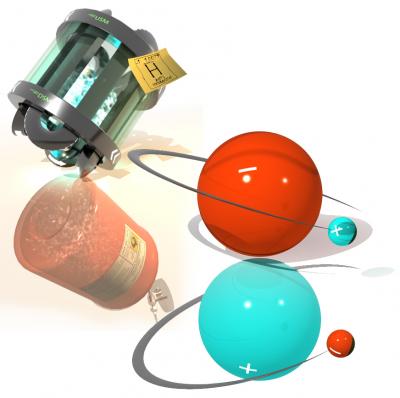The ALPHA collaboration at CERN has for the first time carried out the spectroscopic measurements of the internal structure of antihydrogen atom using a specially designed magnetic bottle called Minimum Magnetic Field Trap.
 Like ordinary hydrogen, a single electron orbiting a proton nucleus, antihydrogen is the simplest of atoms, a single positron (antielectron) orbiting a single antiproton. CERN's ALPHA experiment was first to trap antihydrogen in a magnetic bottle, using a superconducting octupole magnet. (Credit: Images by Chukman So, copyright © 2011 Wurtele Research Group. All rights reserved.)
Like ordinary hydrogen, a single electron orbiting a proton nucleus, antihydrogen is the simplest of atoms, a single positron (antielectron) orbiting a single antiproton. CERN's ALPHA experiment was first to trap antihydrogen in a magnetic bottle, using a superconducting octupole magnet. (Credit: Images by Chukman So, copyright © 2011 Wurtele Research Group. All rights reserved.)
Researchers at the Lawrence Berkeley National Laboratory of the U.S. Department of Energy helped in designing and modeling the Minimum Magnetic Field Trap. The trap is formed by superconducting magnets whose fields trap antihydrogen atoms.
In a series of experiments, the ALPHA scientists produced and trapped hundreds of antihydrogen atoms in the Minimum Magnetic Field Trap and then bathed them in a microwave radiation to study their internal structures. During the bathing, the positrons’ spin was flipped by the microwave radiation, causing the release of the atoms from the magnetic bottle and their subsequent annihilation over the wall of the bottle.
The microwave radiation’s frequency needed to flip antihydrogen’s spins can be used as a direct measure of the variation in energy between antihydrogen’s two hyperfine states. Until now, the measurement is inaccurate as the amount of the energy difference relies on scale of the magnetic field in the antihydrogen trap of ALPHA.
The ALPHA scientists utilized two different techniques namely the disappearance method and the appearance method to collect data pertaining to the internal states of antihydrogen atoms. In the disappearance method, the superconducting magnets of the trap is suddenly turned off to trap an average count of anti-atoms in a period and these anti-atoms are then counted when they annihilate themselves against the ordinary-matter walls of the experiment. In certain trails, the microwaves are activated at the resonant frequency, which is measured to flip the positron spins. In other trials, the microwaves are activated at some other frequency, while they are not activated at all in some other cases. These results confirm that the resonant frequency is the right frequency capable of flipping the spins of anti-atoms and releasing them.
In the appearance test, the anti-atoms are seized in the trap for three minutes to count every annihilation that occurs during the flipping of a spin of an anti-atom by the microwave and its release from the trap. The ALPHA researchers have plans to use a laser beam to study the trapped anti-atoms as it can efficiently measure the antihydrogen’s energy levels. Moreover, lasers are able to make anti-atoms nearly motionless by cooling them, allowing accurate measurements of their properties.
The researchers think that antihydrogen and hydrogen are identical. However, there may be a difference between the atomic spectrum of ordinary hydrogen and that of antihydrogen and this difference is yet to be confirmed. The research findings have been reported in Nature.